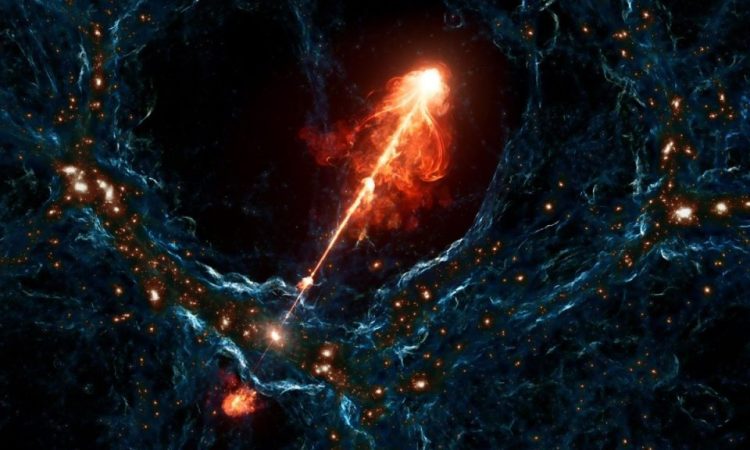
The largest pair of jets emitted by a black hole ever observed has been discovered, spanning 23 million light years.
Discovered by an international research team a long pair of gigantic jets of gases and particles produced by a remote black hole supermassive, extending for a distance of 23 million light yearsor as much as the diameter of 140 galaxies like the Milky Way. The megastructure, the largest of its kind known so far, has been nicknamed Porphyrion in honor of a giant from Greek mythology. These date back to a time when our universe was 6.3 billion years old, which is less than half its current age of 13.8 billion years. The energy powering the jets is estimated to be equivalent to that of trillions of suns.
Advertisement
Relativistic jets
Before this discovery, the largest jet system ever observed was Alcyoneus, detected in 2022, with an extension of about 100 times the size of the . But Porphyry’s discovery suggests that these giant jet systems may have influenced the formation of galaxies in the young universe more than previously thought.
“The discovery of Porphyrion represents a very important step in understanding the evolution of black holes and galaxies, with potentially relevant implications also for the properties of the“, comments Andrea BotteonINAF researcher involved in the study. “This result was possible thanks to the use of the vast network of antennas that make up LOFAR, which allowed us for the first time to identify Porfirione and therefore to conduct follow-up with other telescopes to determine their physical properties.”
Thanks to the European radio LOFAR (LOw Frequency ARray), in addition to Porfirione, over 10,000 barely visible megastructures have been discovered. Although hundreds of large jet systems were already known before the LOFAR observations, they were thought to be rare and on average smaller in size than the thousands of systems discovered. “This pair is not just the size of a solar system or a Milky Way; we’re talking about 140 diameters of the Milky Way in total,” he says Martijn Oopsa postdoctoral researcher at Caltech and lead author of a new paper published in Nature. “The Milky Way would be a small dot in these two gigantic eruptions.”
To locate where Porphyrion came from, the team used the Giant Metrewave Radio Telescope (GMRT) in India along with data from a project called the Dark Energy Spectroscopic Instrument (DESI), which operates from the Kitt Peak National Observatory in Arizona. The observations identified the origin of the jets: a galaxy about ten times more massive than our Milky Way.
The influence of black holes on the Universe
The team then used the WM Keck Observatory in Hawaii to show that Porphyrion is 7.5 billion from Earth. This result suggests that if distant jets like these can reach the scale of the cosmic web, then every location in the universe may have been affected by black hole activity at some point in cosmic history.
Observations from the Keck telescope also revealed that Porphyry comes from what is called a black hole active in radiative mode, rather than jet mode. In this particular state, the supermassive black hole emits energy in the form of radiation and jets when it attracts e: a surprise for the researchers, who did not believe it was possible to emit such powerful jets from a black hole in this mode. The discovery therefore suggests that in the distant universe, where radiative black holes abound, there may be many more such powerful jets yet to be discovered.
How the jets can extend so far beyond their host galaxies without destabilizing is still unclear. The most plausible hypothesis is that an unusually long-lasting and stable event occurs in the host galaxy around the central supermassive black hole to allow it to remain active for so long – about a billion years – and ensure that the jets continue to point in the same direction throughout that time.
“Low-frequency observations continue to show their incredible potential,” he says Francesco de Gasperinco-author of the study and INAF researcher. “Being able to correctly observe and process this data is extremely complex, but in recent years great strides have been made which have allowed a large number of important discoveries, including many on and on their impact on modifying the life of host galaxies.”
Next observations
The next step for the researchers will be to delve deeper into how these affect their environment and, in particular, how the jets spread cosmic rays, heat, heavy atoms and magnetic fields into intergalactic space. Another objective of scientists is also to understand the mechanisms that are linked to the propagation of the magnetic fields associated with these enormous jets, the way in which they influence the distribution of magnetic fields in the large cosmic network and the role that magnetic fields can have on the formation and the maintenance of conditions favorable to life, as happens on our planet.
If you have come this far it is because you considered our article worthy of being read to the end. Passione Astronomia has always tried to build, through scientific dissemination, a community of more informed and aware people. It’s also why we decided to write a book dedicated to astronomy. It is written in a clear and simple way, precisely because for us disclosure must be accessible to everyone. You find it .
Read more

